Hydraulic machines
In this chapter you will investigate how hydraulic systems are used in some practical situations.
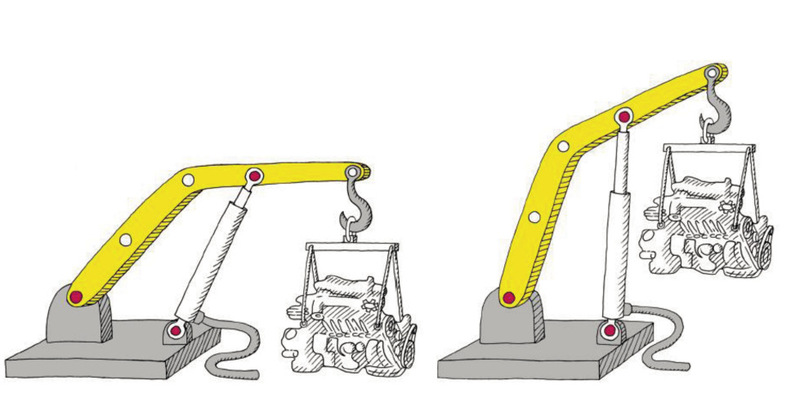
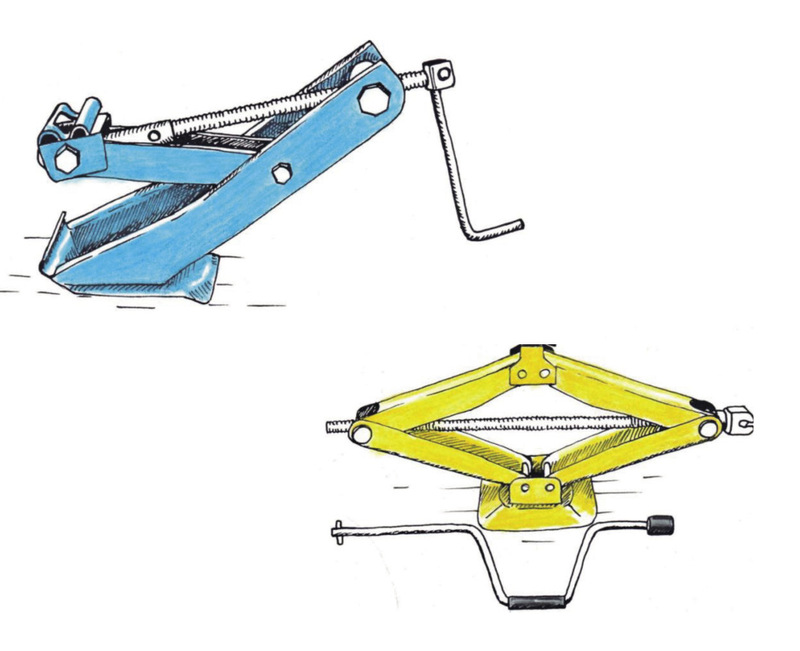
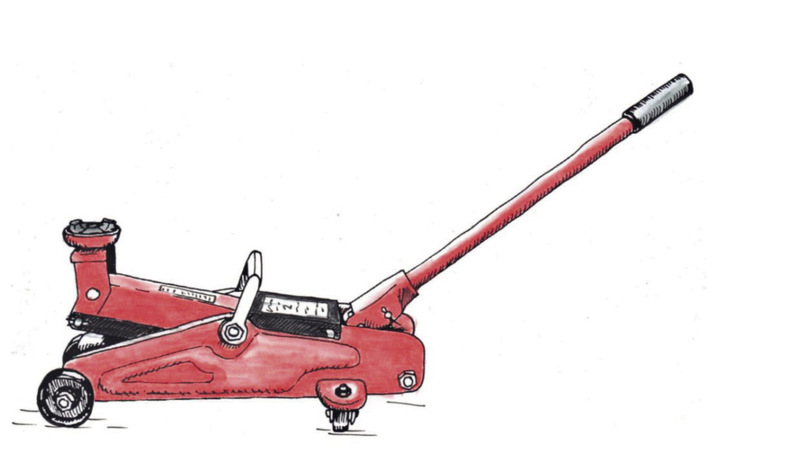
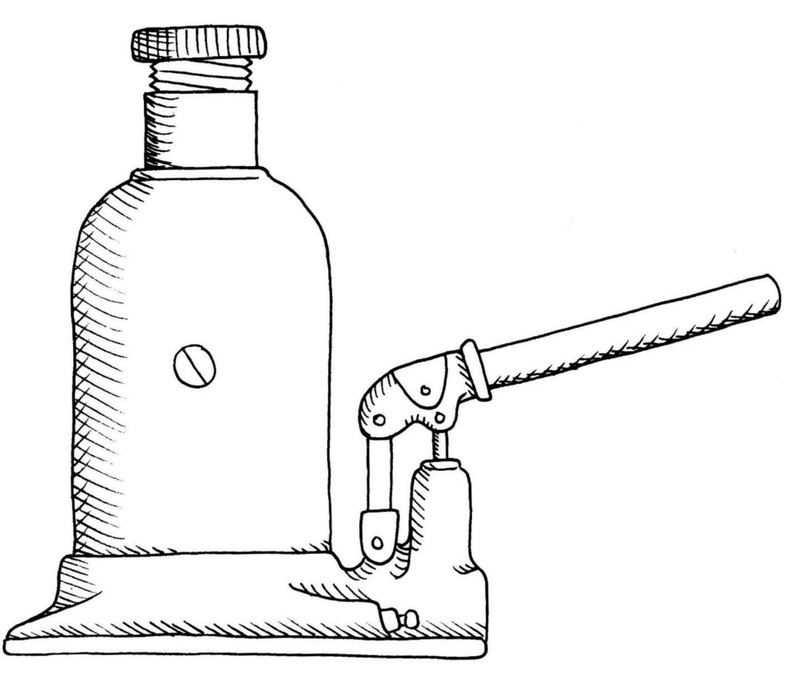
Using pressure to get things done
If you press a plastic bottle down hard on a sheet of paper, you can make a perfectly round mark on that paper.
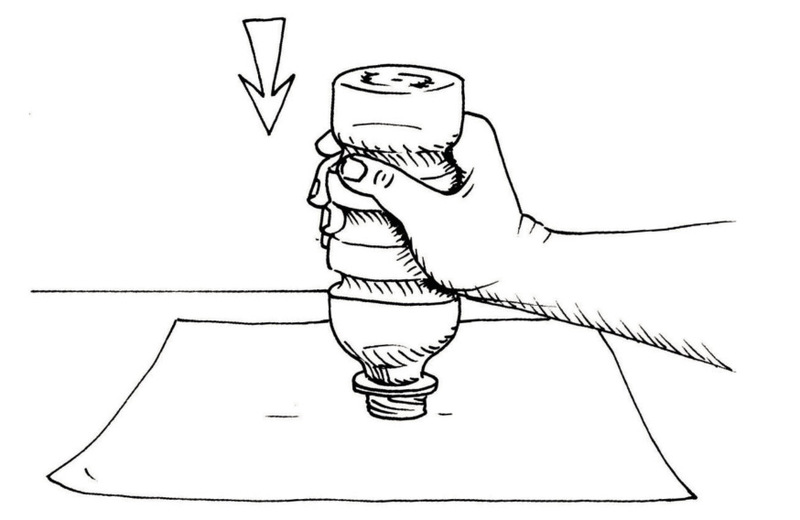
You can also use a bottle like this to press cookies out of a sheet of dough. Flat plastic or metal objects such as washers can be made in the same way, by pressing them out of plastic or metal sheets. With metal, you have to press down very hard.
-
Tom wants to use two hard steel tubes with sharp edges to press washers from a sheet of iron. Can he use a type of lever to help him exert enough force to press the steel tubes through the iron sheet?
Make a sketch on the next page to show how this can be done. The machine that you design can be called a washer-making press.
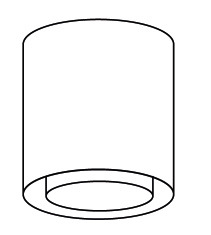
Figure 6 
Instead of using a lever to exert a big enough force to cut the washers, a hydraulic pushrod can be used.
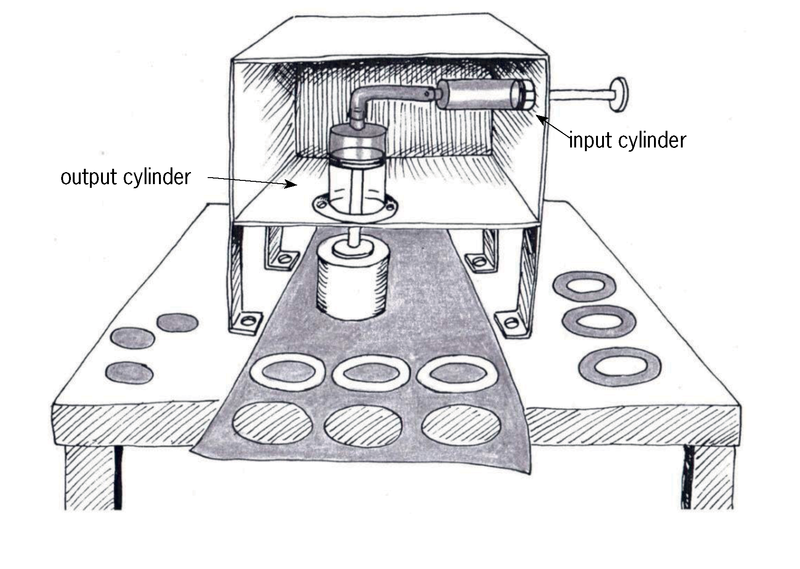
A machine like this is called a hydraulic press.
The mechanical advantage gained by using an output cylinder that is wider than the input cylinder is used in a hydraulic press.
Many towns in South Africa use garbage trucks to collect garbage bags and other rubbish.

This truck can carry 15 cubic metres of rubbish, which is roughly 120 garbage bags. The truck has a hydraulic press with output cylinders that can compress the rubbish with a force of fifteen tons or 15 000 kg. If you want to know how big that force is, think about how heavy a full two litre bottle of cold drink feels in your hand. Now imagine you are holding 7 500 of them!
Because the truck compresses the rubbish, it can pick up about 2 000 bags before it is full. How does a hydraulic press work?
Look at the syringe system shown here. If you push the input plunger with your one hand, the output plunger will push up against your finger.
If the output plunger is wider than the input plunger, the output force is bigger than the input force. The mechanical advantage is bigger than 1.
If the output plunger is narrower than the input plunger, the output force is smaller than the input force. In this case the mechanical advantage is smaller than 1.
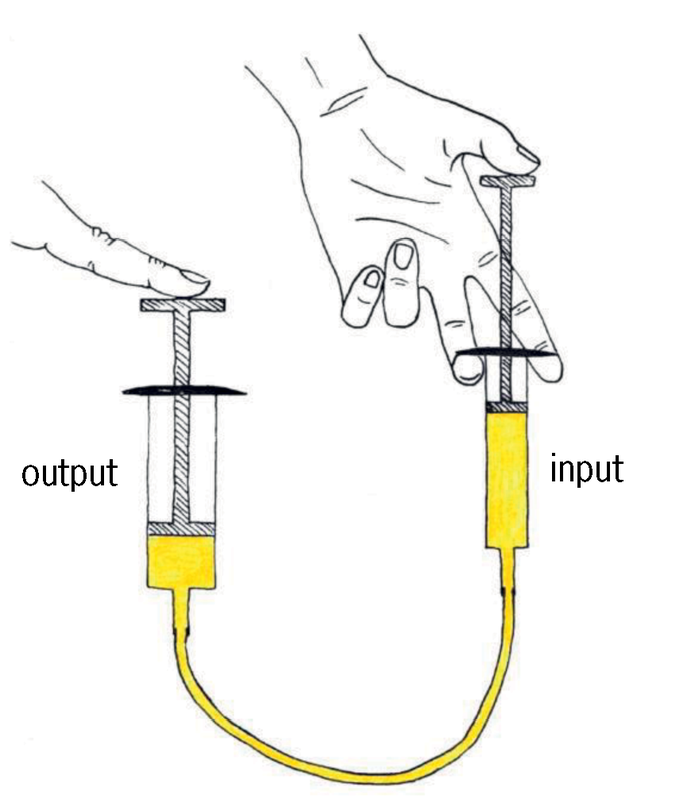
Figure 10 shows the same type of system as Figure 9. The yellow part is water or another type of liquid. The red and blue parts are cylinders that can move up and down.
-
-
Imagine a hydraulic system such as this that is about 50 cm high. If the blue cylinder is pushed down by 5 cm, will the red cylinder move upwards by 5 cm, by less than 5 cm or by more than 5 cm?
-
Suppose a load, for example a box with apples,is placed on top of the red cylinder.Will the upwards force on the load be thesame as the downward force exerted on theblue cylinder. Or will it be bigger or smaller?
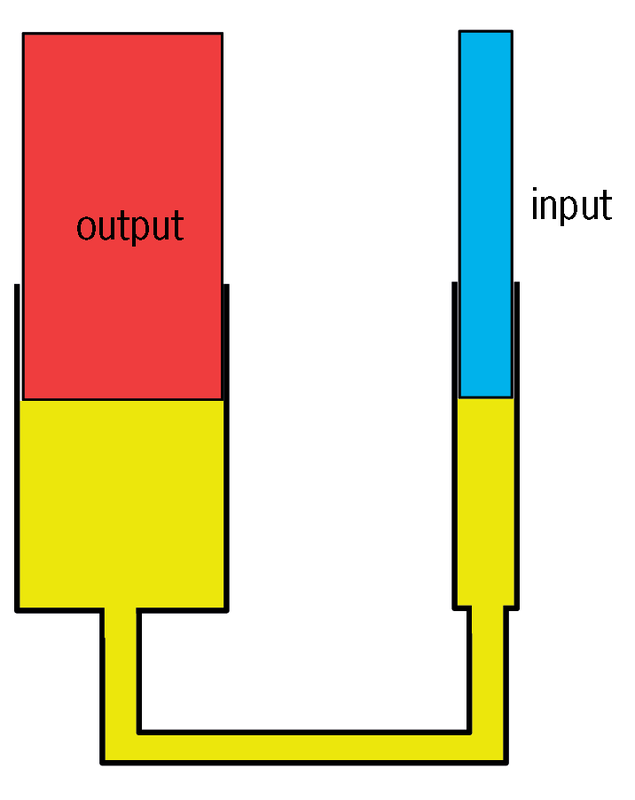
Figure 10
-
If the output cylinder in a simple hydraulic system is wider than the input cylinder, the output distance is smaller than the input distance, but the output force is bigger than the input force.
Calculations about hydraulic systems
-
A hydraulic system with rectangular cylinders is shown below. The surface area of the red cylinder top is four times bigger than the surface area of the blue cylinder top.
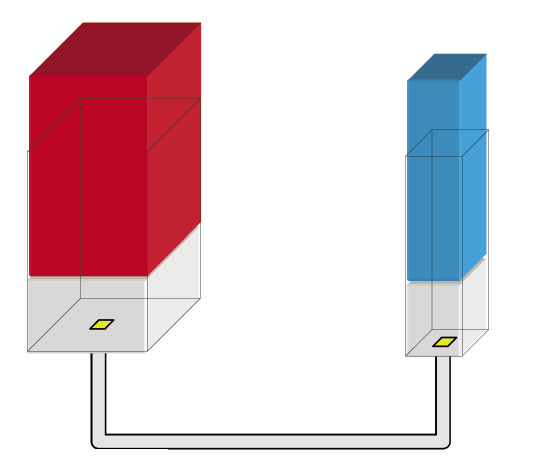
Figure 11 -
The volume of liquid that is pushed down on the right rises up on the left and pushes the red cylinder upwards.
-
If the blue cylinder moves down by 12 mm, by how much will the red cylinder move up?
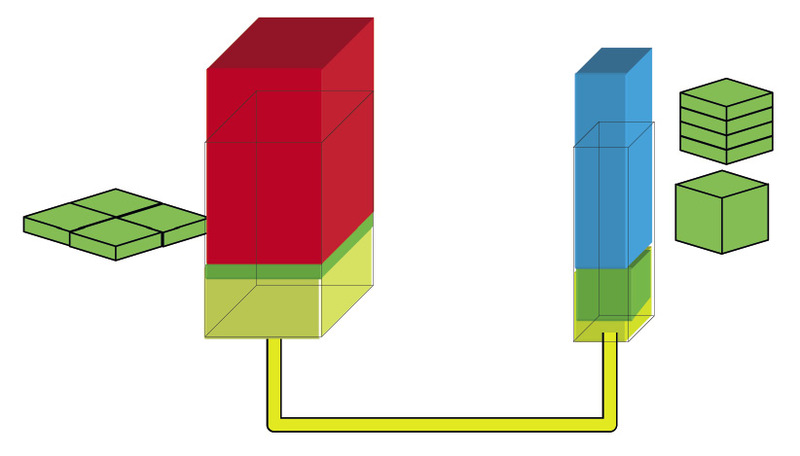
Figure 12 The surface area of the top of a cylinder is the same as the surface area of the base of the cylinder, and it is the same as the surface area of any cut that one makes at a right angle with the height of the cylinder. It is called the cross-sectional area.
If you struggle to understand what is written above, think of a roll of polony or a brick-shaped bread. Every piece that you cut from the polony or bread has exactly the same shape and size, and therefore also has the same surface area.
If the blue cylinder is pushed down through the green volume on the right, the red cylinder will move up through the green volume on the left.
If the surface area of the base of the output cylinder is four times the surface area of the base of the input cylinder, the output force will be four times as big as the input force. The output distance will be ¼ of the input distance.
In this case the mechanical advantage is four, and the distance advantage is ¼.
-
In the system shown in Figure 13, the surface area of the output cylinder top is nine times the surface area of the input cylinder top.
-
What is the mechanical advantage of this system?
-
What is the distance advantage of this system?
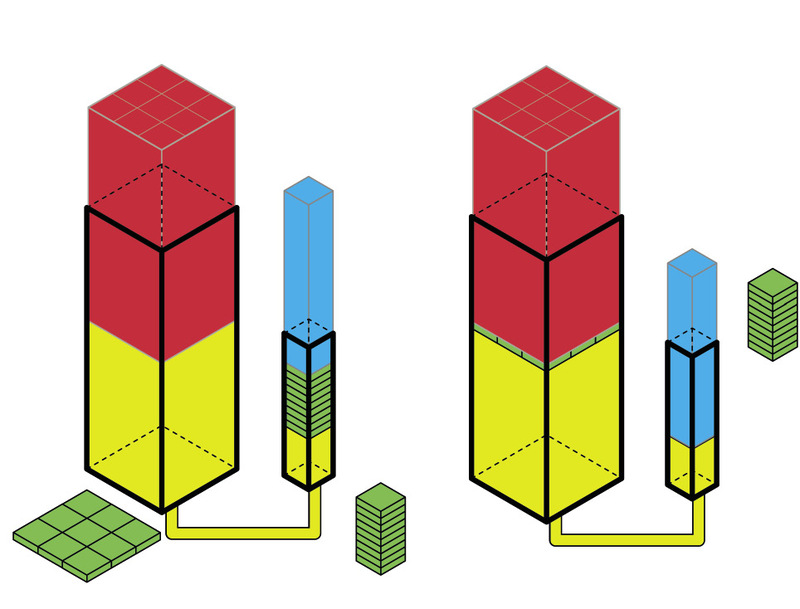
Figure 13
-
-
In a particular hydraulic press, the output cylinder moves by 2 cm when the input cylinder is moved through 10 cm. How much stronger is the output force than the input force?
-
In another hydraulic press, the area of the output cylinder top is 40 cm2 and the area of the input cylinder top is 5 cm2.
-
How far will the output cylinder move if the input cylinder is moved through 16 cm?
-
How far do you need to push the input cylinder so that the output cylinder will move through 24 cm?
-
The hydraulic car jack
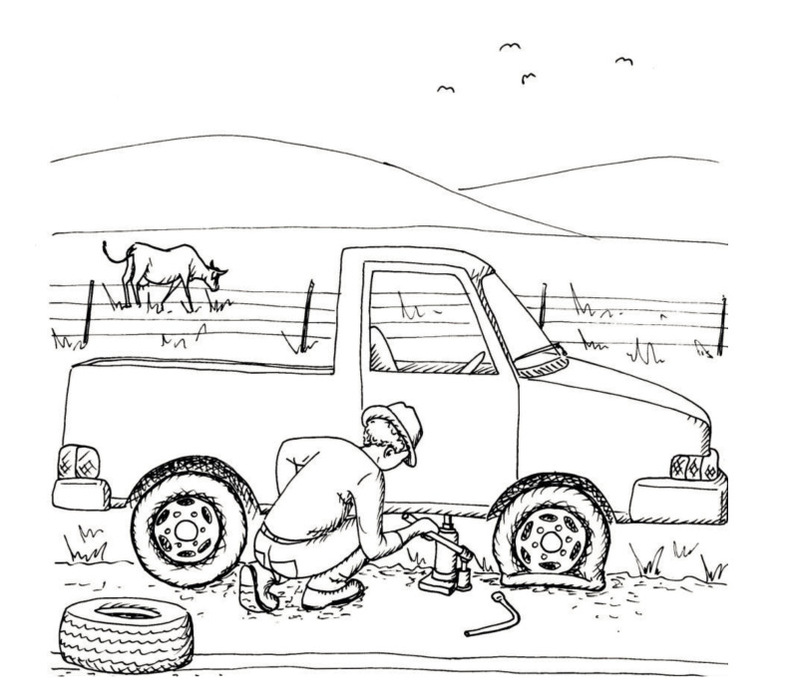
When a tyre goes flat, you need to lift the car up to take the wheel off and fit another wheel. Since a car is too heavy to lift with your bare hands, a device that provides a mechanical advantage is needed.
A device that is used to lift cars so that wheels can be changed is called a jack. A jack provides a mechanical advantage.
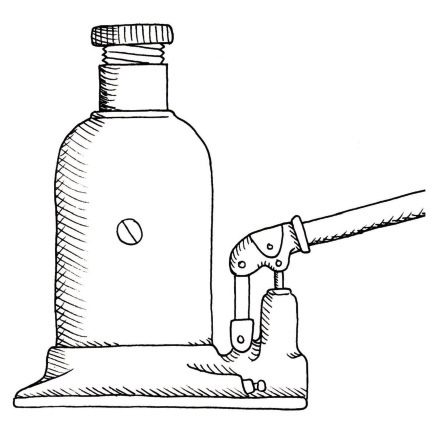
A bottle jack has a hydraulic pushrod system inside, that provides a mechanical advantage. When the blue input cylinder is pushed down by some distance, the red output cylinder moves up with a bigger force, but by a much smaller distance.
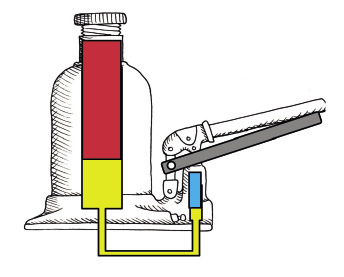
-
Look at Figure 14. Do you think the car will be lifted high enough when the input cylinder is pressed down?
To lift the car up high enough, the output cylinder will have to be pushed up quite a number of times. To do that the input cylinder will have to be pulled upwards each time, so that it can be ready for a next downward push. Think of syringes to understand what will happen. You can even experiment with two syringes of different sizes again.
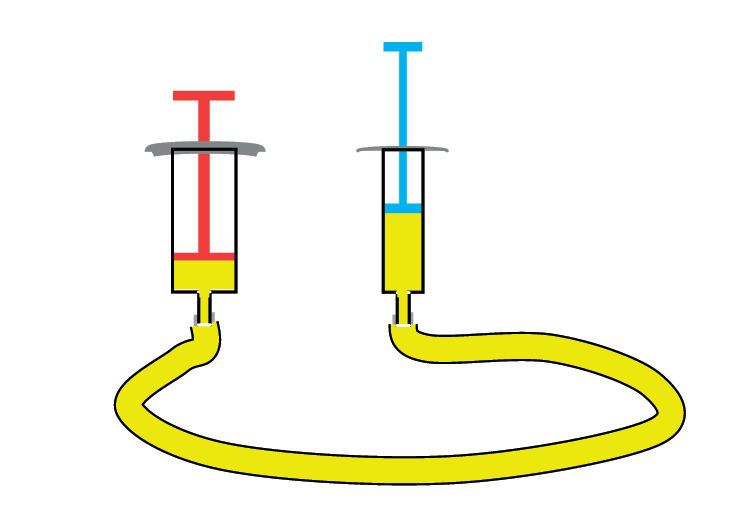
Figure 17 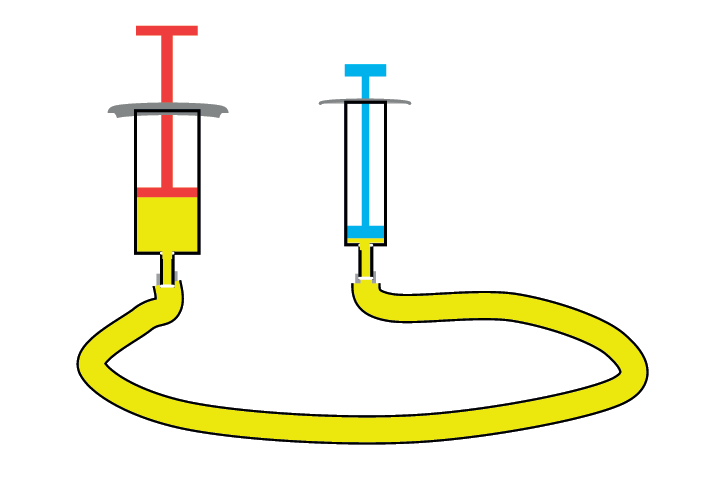
Figure 18 -
When the blue input plunger is pressed in, the red output plunger moves out. What do you think will happen if the blue input plunger is now pulled out again?
If the output cylinder could remain where it is after the input cylinder has been pushed downwards, then the output cylinder could be pushed higher every time the input cylinder is pushed down.
To make this possible, more oil will be needed. A real hydraulic bottle jack has an extra container with oil, as shown in the diagram below.
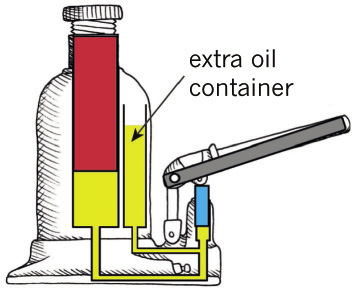
To make the red cylinder stay in place each time the blue cylinder is pulled upwards, the oil should be prevented from being sucked out from underneath the red cylinder. Perhaps something like a water tap should be placed at the white box in the diagram on the right.
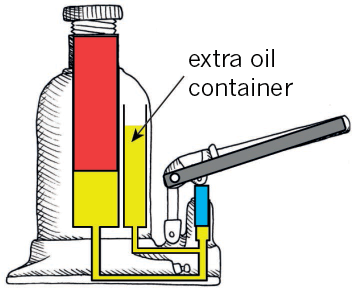
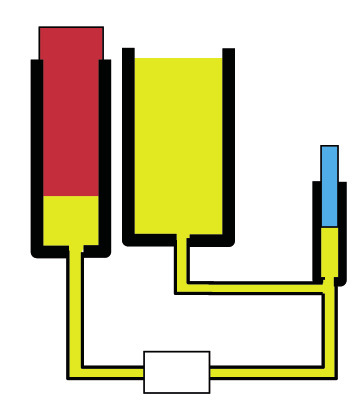
A ball valve such as those on the right allows liquid to flow in one direction through a tube, but not in the other direction. This ball valve consists of a ball that is connected to a spring. The spring pushes the valve against the opening, so that no liquid can flow through.
If the liquid tries to flow from the left to the right, the ball is pushed away from the opening, and the liquid can pass through.


The main part of a hydraulic car jack is a big output cylinder that sticks out of the top of the bottle shape. This lifts the car up when you pump the handle.
Inside the bottle is a tank with oil. The oil from this tank passes through a ball valve into the space where the input cylinder is. The ball valve does not allow the fluid to pass back.
The pump handle connects to the small input cylinder and pushes it in like the plunger in a syringe. As you pump, the input cylinder goes up and down, forcing the oil to the output cylinder through another ball valve.
The output cylinder pushes up a small distance each time the input cylinder is pushed down, but with a big force that lifts the car up.
When the input cylinder is pushed downwards, the red valve closes and the blue valve opens. The oil is then pushed past the blue valve and pushes the output cylinder upwards.
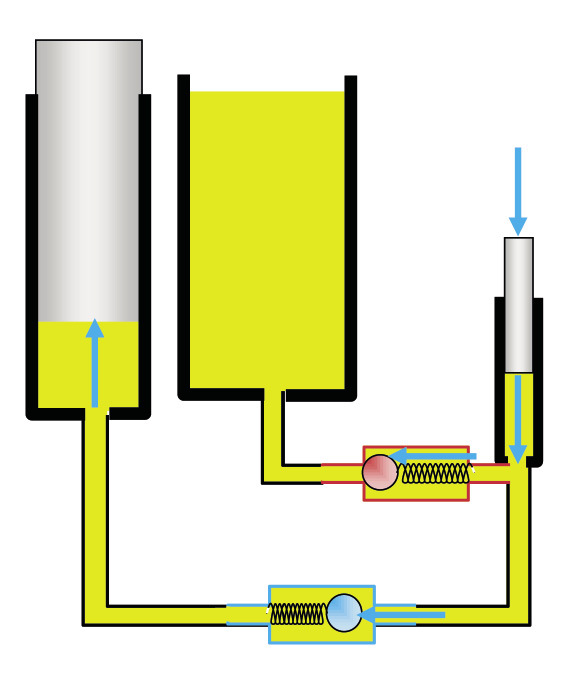
When the input cylinder is pulled upwards, the red valve opens and oil is drawn in from the tank. The blue valve closes, so that oil cannot flow back from the side of the output cylinder. As a result, the output cylinder does not move while the input cylinder is pulled upwards.
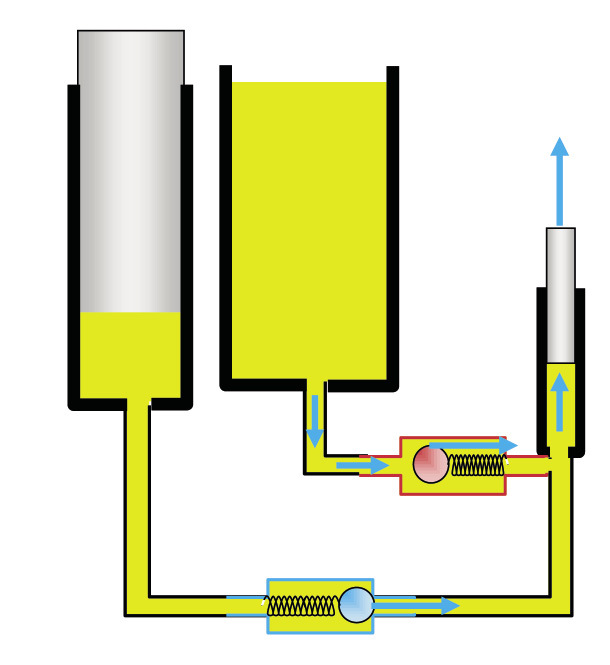
Make a systems diagram of how a hydraulic car jack works on the next page. The picture below can help you to think of the different things that happen between the input and output of a car jack. The systems diagram must show in different steps what happens inside the jack if you press down and pull back the lever twice.
Note that the additional tank of oil in the drawing below has a hole inside it into which the output cylinder fits. This tank is also called the "oil reservoir" of the hydraulic system.
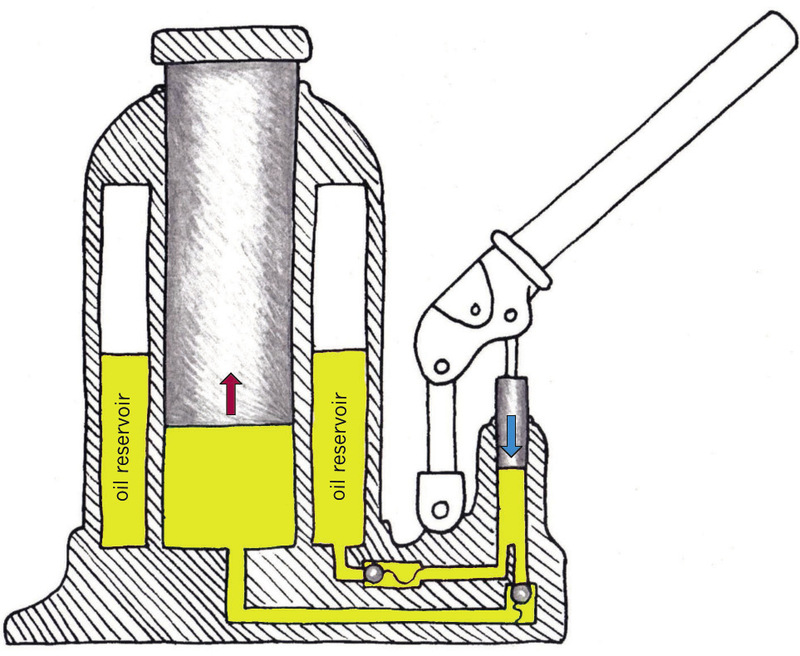
Sketch your systems diagram of a car jack on this page.

An important question
What safety precautions should people take when using car jacks?
Evaluate the design of a hydraulic car jack
-
Who uses hydraulic car jacks?
-
What do you do with a hydraulic car jack?
-
Is a hydraulic car jack a good tool to lift a car? Explain.
-
4. What materials are hydraulic car jacks made of?
-
What does a hydraulic car jack cost, more or less?
-
Is it worth paying that amount for a hydraulic car jack?
-
Is it necessary for a hydraulic car jack to look pretty?
-
Is a hydraulic car jack safe to use?
Next week
During this week, you learnt how valves can be used to control the movement of oil and of the output cylinder of a car jack. Next week, you will learn about other ways to control movement. You will also learn about pulleys and pulley systems.



